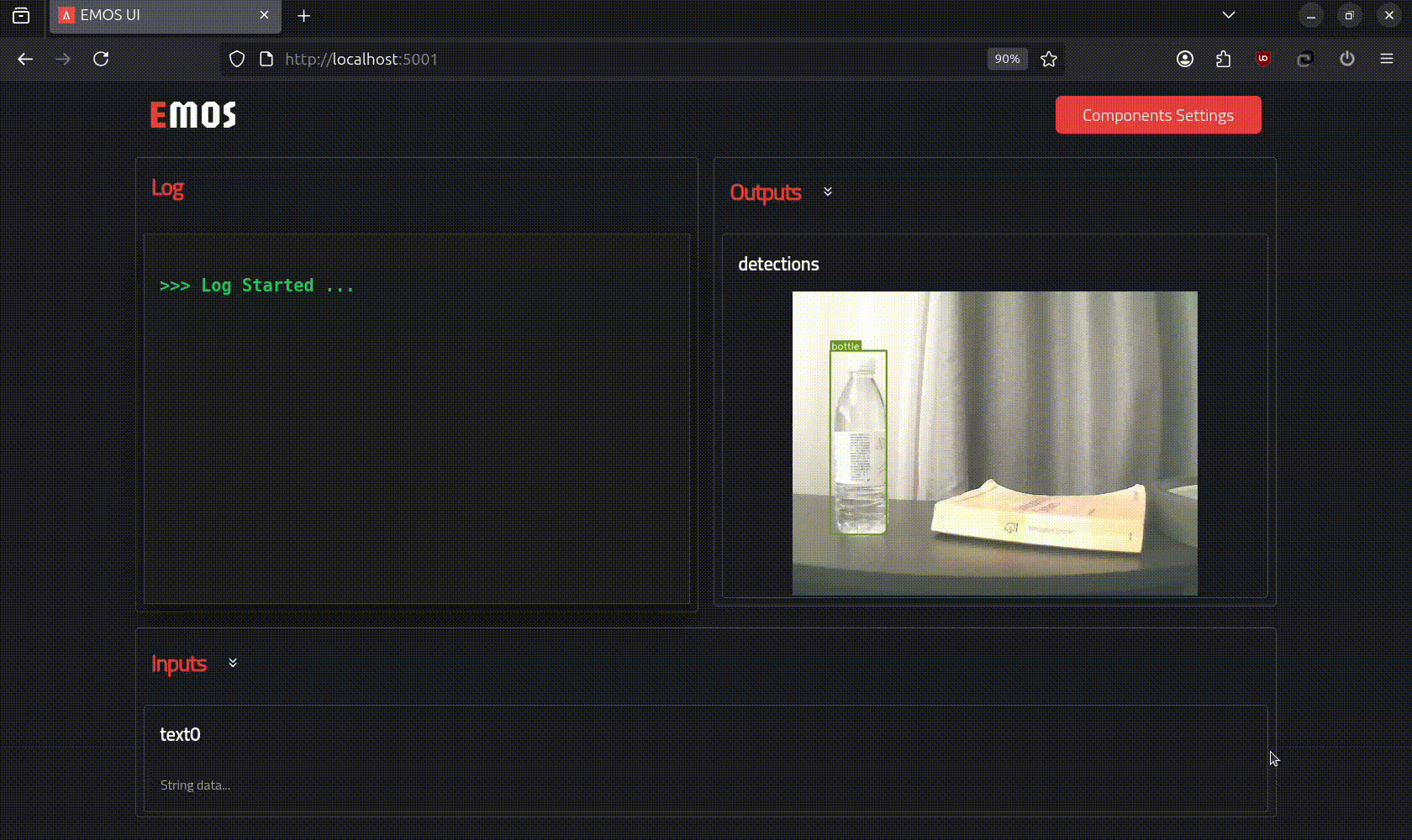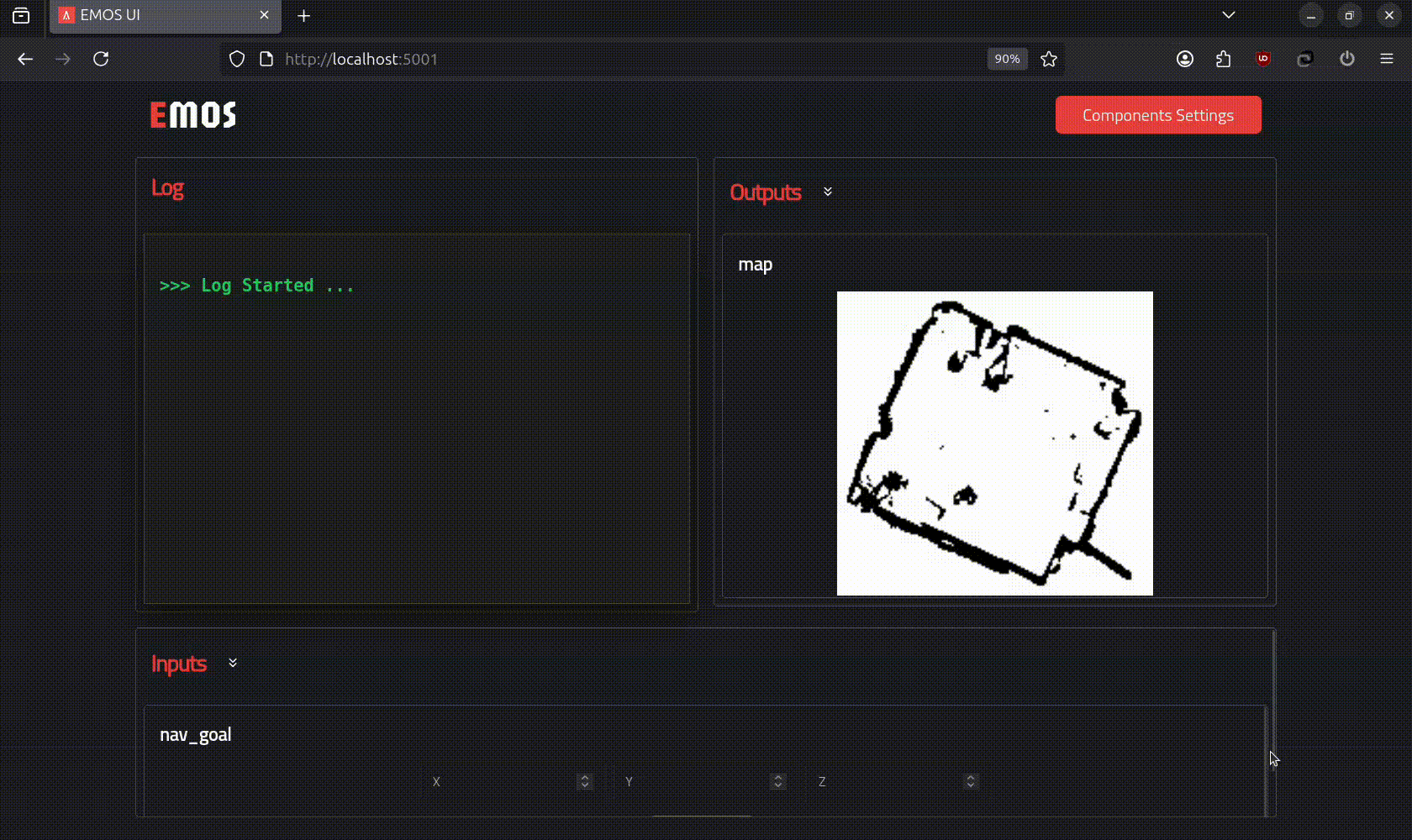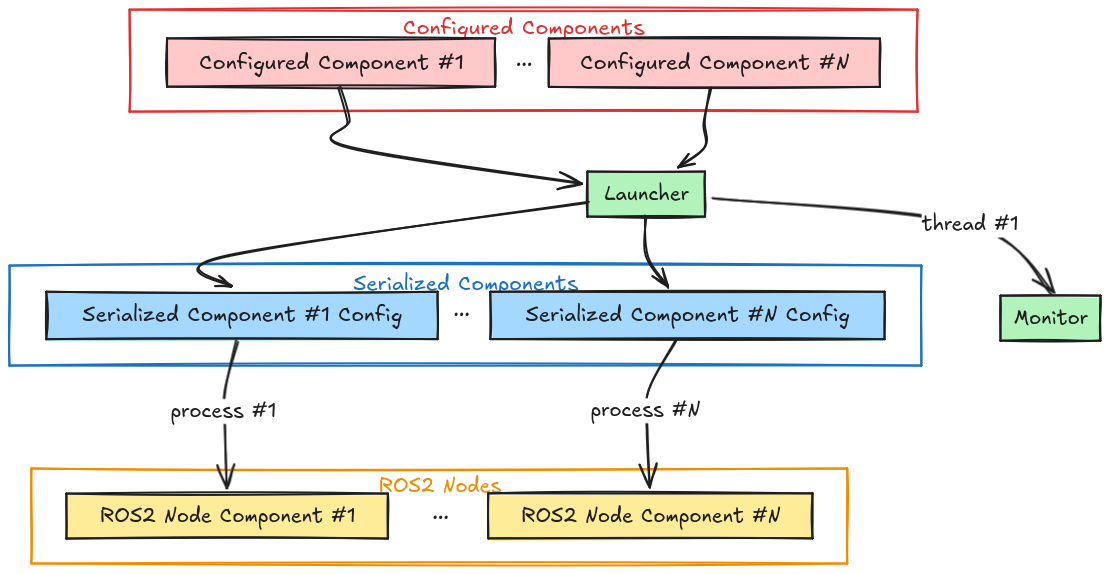Repository Summary
| Description | Sugarcoat 🍬 is a meta-framework that provides a whole lot of syntactic sugar for creating event-driven multinode systems in ROS2, using an intuitive Python API. |
| Checkout URI | https://github.com/automatika-robotics/ros-sugar.git |
| VCS Type | git |
| VCS Version | main |
| Last Updated | 2025-11-07 |
| Dev Status | DEVELOPED |
| Released | RELEASED |
| Tags | robotics ros ros2 ros-api ros-launch-api |
| Contributing |
Help Wanted (-)
Good First Issues (-) Pull Requests to Review (-) |
Packages
| Name | Version |
|---|---|
| automatika_ros_sugar | 0.4.1 |
README

| 🇨🇳 简体中文 | 🇯🇵 日本語 |
The Sweetest Way to Build ROS2 Systems
Sugarcoat is a meta-framework that injects a whole lot of syntactic sugar into building complex, event-driven multinode systems in ROS2, all through an intuitive Python API.
Key Features
| Feature | Description |
|---|---|
| Event-Driven Core | Built-in primitives for Events and Actions enables dynamic runtime configuration and control over your system’s Components. |
| Built-in Resilience | Fallbacks and Fault Tolerance are core design concepts, ensuring your systems are robust and reliable. |
| Intuitive Python API | Design your entire system—nodes, events, and actions—using clean, readable Python code. |
| Dynamic Web UI (NEW!) | Automatically generate a fully dynamic, extensible web interface for monitoring and configuring your system. |
| Launch Replacement | A more pythonic alternative to the ROS2 Launch API, providing greater flexibility and runtime control for real-world applications. |
Packages Built with Sugarcoat
- Kompass: A framework for building robust and comprehensive event-driven navigation stacks using an easy-to-use and intuitive Python API.
- EmbodiedAgents: A fully-loaded framework for creating interactive physical agents that can understand, remember, and act upon contextual information from their environment.
Get Started
- Learn more about the design concepts in Sugarcoat 📚
- Learn how to create your own ROS2 package using Sugarcoat 🚀
(NEW!) Introducing Dynamic Web UI for Sugarcoat Recipes
The new Dynamic Web UI feature takes system visibility and control to the next level. Built with FastHTML and MonsterUI, it is designed to automatically generate a fully dynamic, extensible web interface for any Sugarcoat recipe, completely eliminating the need for manual front-end development.
This feature instantly transforms your complex, multinode ROS2 system into a monitorable and configurable web application.
Automatic UI Generation in Action
See how the Web UI effortlessly generates interfaces for different types of Sugarcoat recipes:
- Example 1: General Q\&A MLLM Recipe A fully functional interface generated for an MLLM agent recipe from EmbodiedAgents, automatically providing controls for settings and real-time text I/O with the robot.

- Example 2: Point Navigation Recipe An example for an automatically generated UI for a point navigation system from Kompass. The UI automatically renders map data, and sends navigation goals to the robot.

What’s Inside?
- Automatic Settings UI: Interfaces for configuring the settings of all Components used in your recipe are generated on the fly.
- Auto I/O Visualization: Front-end controls and data visualizations for UI Inputs and Outputs are created automatically.
- WebSocket-Based Streaming: Features bidirectional, low-latency communication for streaming text, image, and audio messages.
- Responsive Layouts: Input and output elements are presented in clear, adaptable grid layouts.
- Extensible Design: Easily add support for new message types and custom visualizations through extensions.
How Sugarcoat Works
The core of Sugarcoat revolves around a few concepts:
- Component: The main execution unit (a ROS2 lifecycle node abstraction) configured with Inputs/Outputs and Fallback behaviors. Each component reports its Health Status. Learn More about Components

-
Events & Actions: Mechanisms to handle and reconfigure components dynamically at runtime. Learn More about Events Learn More about Actions - Launcher: Takes your defined Components, Events, and Actions, and executes the system using multi-threaded or multi-process execution. It works with an internal Monitor to manage component lifecycles and track events. Learn More about the Launcher

CONTRIBUTING
Repository Summary
| Description | Sugarcoat 🍬 is a meta-framework that provides a whole lot of syntactic sugar for creating event-driven multinode systems in ROS2, using an intuitive Python API. |
| Checkout URI | https://github.com/automatika-robotics/ros-sugar.git |
| VCS Type | git |
| VCS Version | main |
| Last Updated | 2025-11-07 |
| Dev Status | DEVELOPED |
| Released | RELEASED |
| Tags | robotics ros ros2 ros-api ros-launch-api |
| Contributing |
Help Wanted (-)
Good First Issues (-) Pull Requests to Review (-) |
Packages
| Name | Version |
|---|---|
| automatika_ros_sugar | 0.4.1 |
README

| 🇨🇳 简体中文 | 🇯🇵 日本語 |
The Sweetest Way to Build ROS2 Systems
Sugarcoat is a meta-framework that injects a whole lot of syntactic sugar into building complex, event-driven multinode systems in ROS2, all through an intuitive Python API.
Key Features
| Feature | Description |
|---|---|
| Event-Driven Core | Built-in primitives for Events and Actions enables dynamic runtime configuration and control over your system’s Components. |
| Built-in Resilience | Fallbacks and Fault Tolerance are core design concepts, ensuring your systems are robust and reliable. |
| Intuitive Python API | Design your entire system—nodes, events, and actions—using clean, readable Python code. |
| Dynamic Web UI (NEW!) | Automatically generate a fully dynamic, extensible web interface for monitoring and configuring your system. |
| Launch Replacement | A more pythonic alternative to the ROS2 Launch API, providing greater flexibility and runtime control for real-world applications. |
Packages Built with Sugarcoat
- Kompass: A framework for building robust and comprehensive event-driven navigation stacks using an easy-to-use and intuitive Python API.
- EmbodiedAgents: A fully-loaded framework for creating interactive physical agents that can understand, remember, and act upon contextual information from their environment.
Get Started
- Learn more about the design concepts in Sugarcoat 📚
- Learn how to create your own ROS2 package using Sugarcoat 🚀
(NEW!) Introducing Dynamic Web UI for Sugarcoat Recipes
The new Dynamic Web UI feature takes system visibility and control to the next level. Built with FastHTML and MonsterUI, it is designed to automatically generate a fully dynamic, extensible web interface for any Sugarcoat recipe, completely eliminating the need for manual front-end development.
This feature instantly transforms your complex, multinode ROS2 system into a monitorable and configurable web application.
Automatic UI Generation in Action
See how the Web UI effortlessly generates interfaces for different types of Sugarcoat recipes:
- Example 1: General Q\&A MLLM Recipe A fully functional interface generated for an MLLM agent recipe from EmbodiedAgents, automatically providing controls for settings and real-time text I/O with the robot.

- Example 2: Point Navigation Recipe An example for an automatically generated UI for a point navigation system from Kompass. The UI automatically renders map data, and sends navigation goals to the robot.

What’s Inside?
- Automatic Settings UI: Interfaces for configuring the settings of all Components used in your recipe are generated on the fly.
- Auto I/O Visualization: Front-end controls and data visualizations for UI Inputs and Outputs are created automatically.
- WebSocket-Based Streaming: Features bidirectional, low-latency communication for streaming text, image, and audio messages.
- Responsive Layouts: Input and output elements are presented in clear, adaptable grid layouts.
- Extensible Design: Easily add support for new message types and custom visualizations through extensions.
How Sugarcoat Works
The core of Sugarcoat revolves around a few concepts:
- Component: The main execution unit (a ROS2 lifecycle node abstraction) configured with Inputs/Outputs and Fallback behaviors. Each component reports its Health Status. Learn More about Components

-
Events & Actions: Mechanisms to handle and reconfigure components dynamically at runtime. Learn More about Events Learn More about Actions - Launcher: Takes your defined Components, Events, and Actions, and executes the system using multi-threaded or multi-process execution. It works with an internal Monitor to manage component lifecycles and track events. Learn More about the Launcher

CONTRIBUTING
Repository Summary
| Description | Sugarcoat 🍬 is a meta-framework that provides a whole lot of syntactic sugar for creating event-driven multinode systems in ROS2, using an intuitive Python API. |
| Checkout URI | https://github.com/automatika-robotics/ros-sugar.git |
| VCS Type | git |
| VCS Version | main |
| Last Updated | 2025-11-07 |
| Dev Status | DEVELOPED |
| Released | RELEASED |
| Tags | robotics ros ros2 ros-api ros-launch-api |
| Contributing |
Help Wanted (-)
Good First Issues (-) Pull Requests to Review (-) |
Packages
| Name | Version |
|---|---|
| automatika_ros_sugar | 0.4.1 |
README

| 🇨🇳 简体中文 | 🇯🇵 日本語 |
The Sweetest Way to Build ROS2 Systems
Sugarcoat is a meta-framework that injects a whole lot of syntactic sugar into building complex, event-driven multinode systems in ROS2, all through an intuitive Python API.
Key Features
| Feature | Description |
|---|---|
| Event-Driven Core | Built-in primitives for Events and Actions enables dynamic runtime configuration and control over your system’s Components. |
| Built-in Resilience | Fallbacks and Fault Tolerance are core design concepts, ensuring your systems are robust and reliable. |
| Intuitive Python API | Design your entire system—nodes, events, and actions—using clean, readable Python code. |
| Dynamic Web UI (NEW!) | Automatically generate a fully dynamic, extensible web interface for monitoring and configuring your system. |
| Launch Replacement | A more pythonic alternative to the ROS2 Launch API, providing greater flexibility and runtime control for real-world applications. |
Packages Built with Sugarcoat
- Kompass: A framework for building robust and comprehensive event-driven navigation stacks using an easy-to-use and intuitive Python API.
- EmbodiedAgents: A fully-loaded framework for creating interactive physical agents that can understand, remember, and act upon contextual information from their environment.
Get Started
- Learn more about the design concepts in Sugarcoat 📚
- Learn how to create your own ROS2 package using Sugarcoat 🚀
(NEW!) Introducing Dynamic Web UI for Sugarcoat Recipes
The new Dynamic Web UI feature takes system visibility and control to the next level. Built with FastHTML and MonsterUI, it is designed to automatically generate a fully dynamic, extensible web interface for any Sugarcoat recipe, completely eliminating the need for manual front-end development.
This feature instantly transforms your complex, multinode ROS2 system into a monitorable and configurable web application.
Automatic UI Generation in Action
See how the Web UI effortlessly generates interfaces for different types of Sugarcoat recipes:
- Example 1: General Q\&A MLLM Recipe A fully functional interface generated for an MLLM agent recipe from EmbodiedAgents, automatically providing controls for settings and real-time text I/O with the robot.

- Example 2: Point Navigation Recipe An example for an automatically generated UI for a point navigation system from Kompass. The UI automatically renders map data, and sends navigation goals to the robot.

What’s Inside?
- Automatic Settings UI: Interfaces for configuring the settings of all Components used in your recipe are generated on the fly.
- Auto I/O Visualization: Front-end controls and data visualizations for UI Inputs and Outputs are created automatically.
- WebSocket-Based Streaming: Features bidirectional, low-latency communication for streaming text, image, and audio messages.
- Responsive Layouts: Input and output elements are presented in clear, adaptable grid layouts.
- Extensible Design: Easily add support for new message types and custom visualizations through extensions.
How Sugarcoat Works
The core of Sugarcoat revolves around a few concepts:
- Component: The main execution unit (a ROS2 lifecycle node abstraction) configured with Inputs/Outputs and Fallback behaviors. Each component reports its Health Status. Learn More about Components

-
Events & Actions: Mechanisms to handle and reconfigure components dynamically at runtime. Learn More about Events Learn More about Actions - Launcher: Takes your defined Components, Events, and Actions, and executes the system using multi-threaded or multi-process execution. It works with an internal Monitor to manage component lifecycles and track events. Learn More about the Launcher

CONTRIBUTING
Repository Summary
| Description | Sugarcoat 🍬 is a meta-framework that provides a whole lot of syntactic sugar for creating event-driven multinode systems in ROS2, using an intuitive Python API. |
| Checkout URI | https://github.com/automatika-robotics/ros-sugar.git |
| VCS Type | git |
| VCS Version | main |
| Last Updated | 2025-11-07 |
| Dev Status | DEVELOPED |
| Released | RELEASED |
| Tags | robotics ros ros2 ros-api ros-launch-api |
| Contributing |
Help Wanted (-)
Good First Issues (-) Pull Requests to Review (-) |
Packages
| Name | Version |
|---|---|
| automatika_ros_sugar | 0.4.1 |
README

| 🇨🇳 简体中文 | 🇯🇵 日本語 |
The Sweetest Way to Build ROS2 Systems
Sugarcoat is a meta-framework that injects a whole lot of syntactic sugar into building complex, event-driven multinode systems in ROS2, all through an intuitive Python API.
Key Features
| Feature | Description |
|---|---|
| Event-Driven Core | Built-in primitives for Events and Actions enables dynamic runtime configuration and control over your system’s Components. |
| Built-in Resilience | Fallbacks and Fault Tolerance are core design concepts, ensuring your systems are robust and reliable. |
| Intuitive Python API | Design your entire system—nodes, events, and actions—using clean, readable Python code. |
| Dynamic Web UI (NEW!) | Automatically generate a fully dynamic, extensible web interface for monitoring and configuring your system. |
| Launch Replacement | A more pythonic alternative to the ROS2 Launch API, providing greater flexibility and runtime control for real-world applications. |
Packages Built with Sugarcoat
- Kompass: A framework for building robust and comprehensive event-driven navigation stacks using an easy-to-use and intuitive Python API.
- EmbodiedAgents: A fully-loaded framework for creating interactive physical agents that can understand, remember, and act upon contextual information from their environment.
Get Started
- Learn more about the design concepts in Sugarcoat 📚
- Learn how to create your own ROS2 package using Sugarcoat 🚀
(NEW!) Introducing Dynamic Web UI for Sugarcoat Recipes
The new Dynamic Web UI feature takes system visibility and control to the next level. Built with FastHTML and MonsterUI, it is designed to automatically generate a fully dynamic, extensible web interface for any Sugarcoat recipe, completely eliminating the need for manual front-end development.
This feature instantly transforms your complex, multinode ROS2 system into a monitorable and configurable web application.
Automatic UI Generation in Action
See how the Web UI effortlessly generates interfaces for different types of Sugarcoat recipes:
- Example 1: General Q\&A MLLM Recipe A fully functional interface generated for an MLLM agent recipe from EmbodiedAgents, automatically providing controls for settings and real-time text I/O with the robot.

- Example 2: Point Navigation Recipe An example for an automatically generated UI for a point navigation system from Kompass. The UI automatically renders map data, and sends navigation goals to the robot.

What’s Inside?
- Automatic Settings UI: Interfaces for configuring the settings of all Components used in your recipe are generated on the fly.
- Auto I/O Visualization: Front-end controls and data visualizations for UI Inputs and Outputs are created automatically.
- WebSocket-Based Streaming: Features bidirectional, low-latency communication for streaming text, image, and audio messages.
- Responsive Layouts: Input and output elements are presented in clear, adaptable grid layouts.
- Extensible Design: Easily add support for new message types and custom visualizations through extensions.
How Sugarcoat Works
The core of Sugarcoat revolves around a few concepts:
- Component: The main execution unit (a ROS2 lifecycle node abstraction) configured with Inputs/Outputs and Fallback behaviors. Each component reports its Health Status. Learn More about Components

-
Events & Actions: Mechanisms to handle and reconfigure components dynamically at runtime. Learn More about Events Learn More about Actions - Launcher: Takes your defined Components, Events, and Actions, and executes the system using multi-threaded or multi-process execution. It works with an internal Monitor to manage component lifecycles and track events. Learn More about the Launcher

